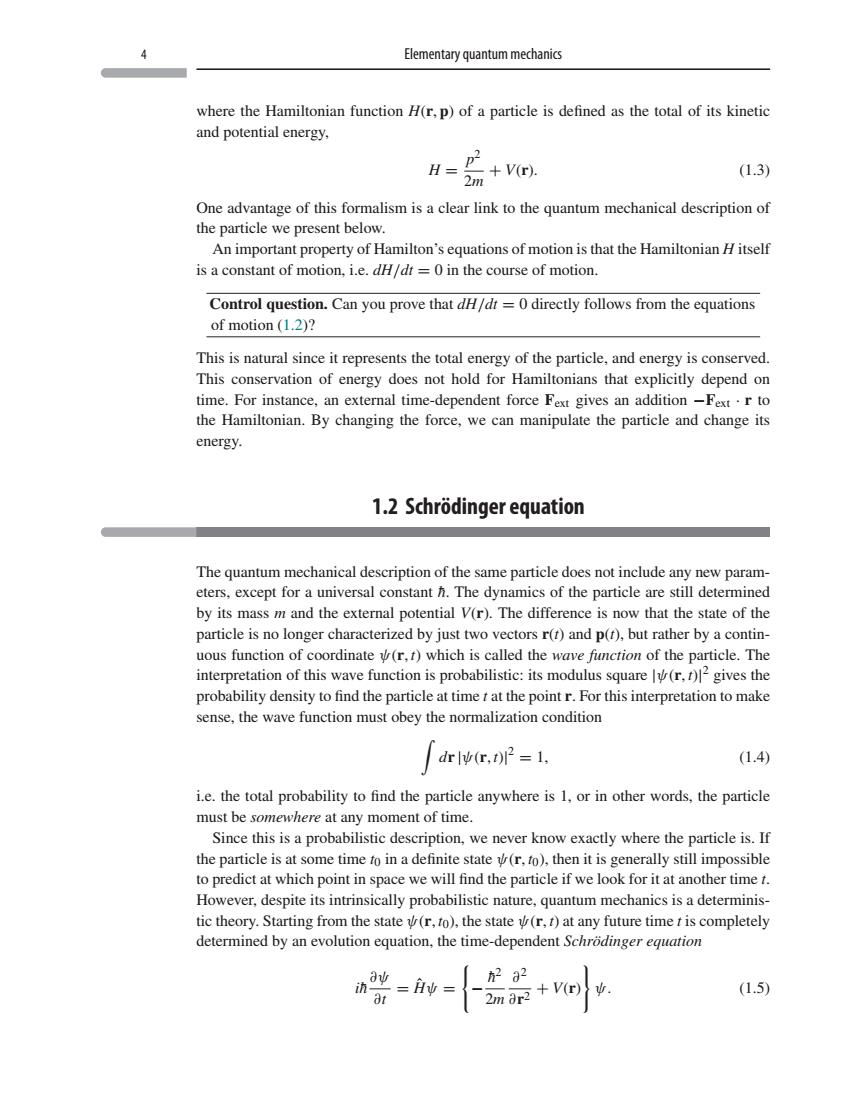正在加载图片...

4 Elementary quantum mechanics where the Hamiltonian function H(r,p)of a particle is defined as the total of its kinetic and potential energy. H= m+V(r). (1.3) One advantage of this formalism is a clear link to the quantum mechanical description of the particle we present below. An important property of Hamilton's equations of motion is that the Hamiltonian Hitself is a constant of motion,i.e.dH/dt =0 in the course of motion. Control question.Can you prove thatH=directly follows from the equations of motion(1.2)? This is natural since it represents the total energy of the particle.and energy is conserved. This conservation of energy does not hold for Hamiltonians that explicitly depend on stance time-dependent force F gives an addition ext·rto the Hamiltonian.By changing the force,we can manipulate the particle and change its energy. 1.2 Schrodinger equation The quantum mechanical description of the same particle does not include any new param eters,except for a universal constant h.The dynamics of the particle are still determined by its mass m and the external potential V(r).The difference is now that the state of the particle is no longer characterized by just two vectors r(t)and p(r),but rather by a contin- ous function of coordinate)which is called the of the particle.The interpretation of this wave function is probabilistic:its modulus square(gives th probability density to find the particle at time t at the point r.For this interpretation to make sense,the wave function must obey the normalization condition dr lv(r.)2=1. (1.4) ie.the total probability to find the particle anywhere is 1.or in other words,the particle must be se mewhere at t any mo ent of time Since this is a probabilistic description,we never know exactly where the particle is.If the particle is at some time to in a definite state(r.to).then it is generally still impossible to predict at which point in space we will find the particle if we look for it at another time t. However.despite its intrinsically probabilistic nature.quantum mechanics is a determinis tic theory.Starting from the state.the state detemied ban volo o.the time-dependent Sompetely =w= 2m丽+ (1.54 Elementary quantum mechanics where the Hamiltonian function H(r, p) of a particle is defined as the total of its kinetic and potential energy, H = p2 2m + V(r). (1.3) One advantage of this formalism is a clear link to the quantum mechanical description of the particle we present below. An important property of Hamilton’s equations of motion is that the Hamiltonian H itself is a constant of motion, i.e. dH/dt = 0 in the course of motion. Control question. Can you prove that dH/dt = 0 directly follows from the equations of motion (1.2)? This is natural since it represents the total energy of the particle, and energy is conserved. This conservation of energy does not hold for Hamiltonians that explicitly depend on time. For instance, an external time-dependent force Fext gives an addition −Fext · r to the Hamiltonian. By changing the force, we can manipulate the particle and change its energy. 1.2 Schrödinger equation The quantum mechanical description of the same particle does not include any new parameters, except for a universal constant h¯. The dynamics of the particle are still determined by its mass m and the external potential V(r). The difference is now that the state of the particle is no longer characterized by just two vectors r(t) and p(t), but rather by a continuous function of coordinate ψ(r, t) which is called the wave function of the particle. The interpretation of this wave function is probabilistic: its modulus square |ψ(r, t)| 2 gives the probability density to find the particle at time t at the point r. For this interpretation to make sense, the wave function must obey the normalization condition dr |ψ(r, t)| 2 = 1, (1.4) i.e. the total probability to find the particle anywhere is 1, or in other words, the particle must be somewhere at any moment of time. Since this is a probabilistic description, we never know exactly where the particle is. If the particle is at some time t0 in a definite state ψ(r, t0), then it is generally still impossible to predict at which point in space we will find the particle if we look for it at another time t. However, despite its intrinsically probabilistic nature, quantum mechanics is a deterministic theory. Starting from the state ψ(r, t0), the state ψ(r, t) at any future time t is completely determined by an evolution equation, the time-dependent Schrödinger equation ih¯ ∂ψ ∂t = Hˆ ψ = − h¯ 2 2m ∂2 ∂r2 + V(r) ψ. (1.5)��